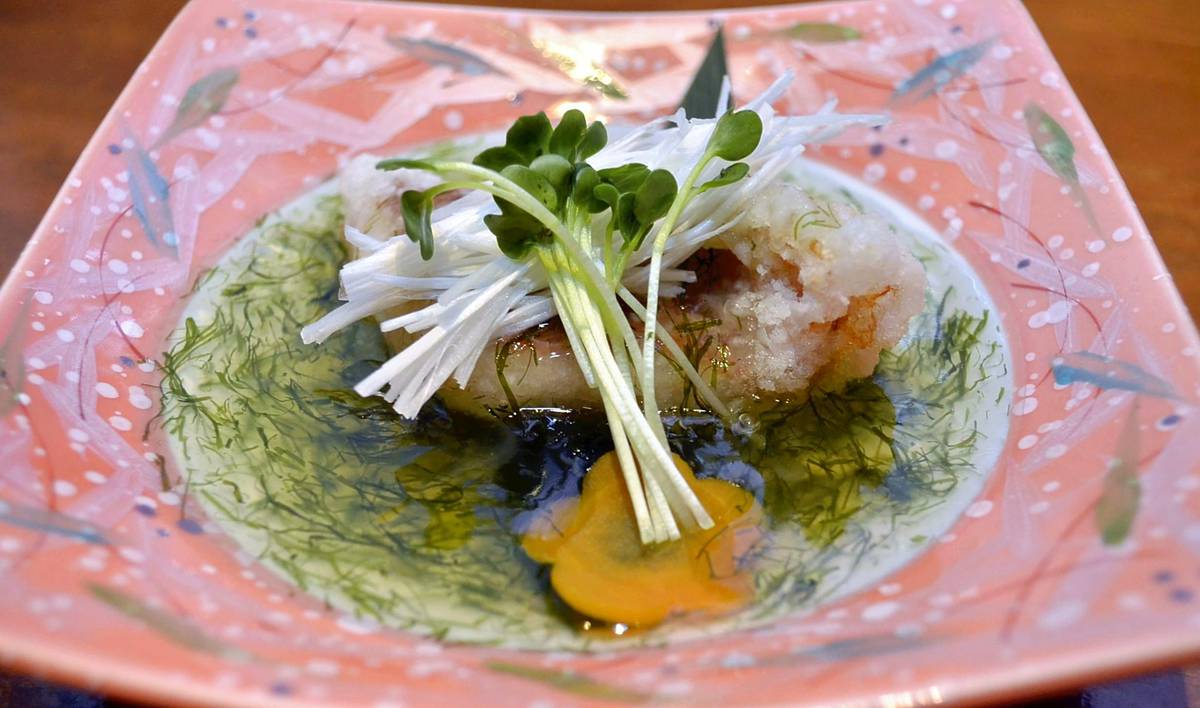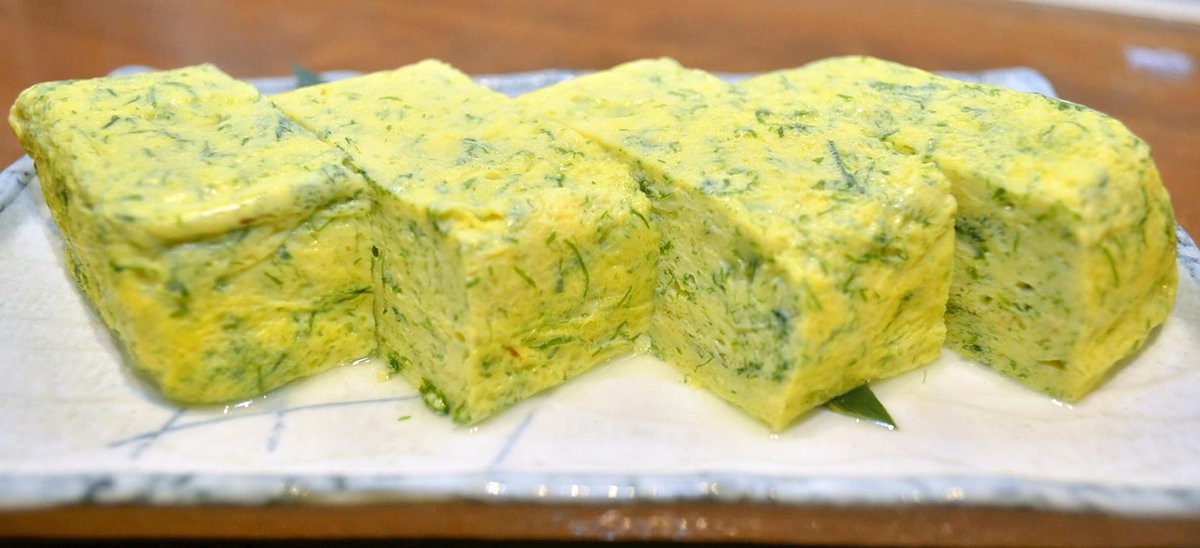Land-Based Seaweed Cultivation Methods Attracting Attention; Operators Use New Techniques to Preserve Traditional Japanese Nori Culture

Sujiaonori is used in a thick and starchy sauce for fried fish.
2:00 JST, November 11, 2024
As the rise in sea temperatures makes cultivation on the ocean’s surface more difficult, land-based methods for growing nori seaweed have begun attracting attention.
There has been a gradual increase in the number of operators working with established technology for cultivating sujiaonori green seaweed.
These methods can be applied to other types of seaweed as well, creating expectations that they may play a role in preserving Japan’s seaweed culture.

A circular tank where sujiaonori is cultivated in Minami-Ise, Mie Prefecture. The machinery in the center rotates, swirling the water and the seaweed.
The Shukutaso fishing port located in the town of Minami-Ise, in the southern part of Mie Prefecture, is a place where iseebi Japanese spiny lobsters and other seafood are brought in.
A striking new building near the port is the home of Minamiise Marine Bio K.K., a company which works on cultivating sujiaonori seaweed.
On the campus, there are several tanks of varying sizes, including 7 meters, 3 meters and 1 meter in diameter. In the center of each tank, a propeller-like hydroponic growing system spins around. A look inside reveals sujiaonori revolving in the current.
President Masahiro Tanaka said: “Instead of being fixed in place, the seaweed floats with the current caused by the movement of the hydroponic growing system, back and forth between the surface and underwater, allowing for full photosynthesis.”
Because seaweed is vulnerable to high temperatures, the company uses inexpensive underground seawater, which is high quality and has a stable temperature.
Sujiaonori is characterized by its dark green color and strong scent, and has traditionally been used to make aonori seaweed powder.
Aonori, which is an essential ingredient in okonomiyaki and takoyaki, is a part of Japanese seaweed culture. The seaweed is pulverized and sprinkled on food, or used in senbei rice crackers and mochi rice cakes. In some regions, it is also added to zoni mochi soup, which is eaten during the New Year.
More than 150 tons of sujiaonori were shipped by producers in Japan each year at the peak of cultivation. Due to such factors as rising sea temperatures, however, production has fallen to about 40 tons, less than a third of what it once was. As prices have risen, food manufacturers and others have been increasingly using alternative products or switching to imports.
Tanaka started the business as a new project for an existing environmental analysis company in 2020, believing that if high-quality sujiaonori could be cultivated on land, it would be possible to preserve Japan’s seaweed culture.
It is common to cultivate nori by attaching its spores to nets and other materials. The company uses a method developed by Kochi University, in which the spores are entangled with each other as they grow, and the nori is cultivated while drifting in seawater.
They are moved to larger tanks according to their level of growth. After a process including being washed, dehydrated and dried with cold air, they are shipped out. The whole process takes about 70 days.
“It takes time, but drying with cold air improves both the color and the scent,” Tanaka said.
Saying that the scent is “as good as herbs,” he named the product “Blue Sea Herb.”
The company produces 4.8 tons of the product per year, which is then shipped to domestic food manufacturers and other customers. The product is also sold at retail. Because it is not reduced to powder at the shipping stage, customers can enjoy the crunchy texture of the nori.
“I hope that people will keep harvesting sujiaonori and use it in various dishes,” he said.
Commercial cultivation of seaweed on land is still rare, except for high-priced products such as sujiaonori and sea grapes.
Prof. Masanori Hiraoka of Kochi University, who developed the technology for cultivating sujiaonori, said: “We are also conducting demonstration experiments with other types of seaweed using the Kochi method. From a technical standpoint, it is possible to cultivate seaweed on land. As cultivation on the ocean’s surface is becoming more difficult, this may grow to play a larger role in the preservation of seaweed.”
“Seaweed cultivation absorbs carbon dioxide. If that seaweed is used in plastic materials and others, it will also serve as a decarbonization measure,” he said.
“It has a different scent”
Various dishes made with sujiaonori are served at Shusai Enishi, a local Japanese-style pub about a 15-minute walk from Kintetsu Ugata Station.

Dashimaki tamago with sujiaonori
One popular dish is the dashimaki tamago (dashi broth-flavored rolled egg) with sujiaonori priced at ¥600.
As I ate it, enjoying the bright green color, a strong scent spread through my mouth.
“When I was a child, I frequently ate sujiaonori that was harvested in this area. We’ve been using cultivated sujiaonori for about three years now, and it has a different scent,” the owner of the pub said.
Sujiaonori is also used on grated nagaimo, in a thick and starchy sauce for fried fish and as sashimi relish.
"Features" POPULAR ARTICLE
-

Sanrio to Open Museum in Yamanashi Pref. Dedicated to Founder, Exhibits Include Hello Kitty, Other Characters
-

Autumn Foliage Surrounds Visitors to Tokyo’s Showa Kinen Park
-

My Daughter No Longer Speaks to Me, But I Want to See Her and My Grandchild
-

Kumamoto: Public Bath Refurbished as Library Where You Can Chat, Take Photos
-

Frozen Vegetables: Demand Rises for Convenient, Tasty Domestic Produce
JN ACCESS RANKING
-

Tokyo Economic Security Forum to Hold Inaugural Meeting Amid Tense Global Environment
-

Keidanren Chairman Yoshinobu Tsutsui Visits Kashiwazaki-Kariwa Nuclear Power Plant; Inspects New Emergency Safety System
-

Imports of Rare Earths from China Facing Delays, May Be Caused by Deterioration of Japan-China Relations
-

University of Tokyo Professor Discusses Japanese Economic Security in Interview Ahead of Forum
-

Japan Pulls out of Vietnam Nuclear Project, Complicating Hanoi’s Power Plans
























